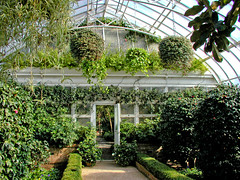- in Gardening by Alexis Rodrigo
How Green Is Your Greenhouse?
For years, many people have trusted greenhouses as a great way to grow quality healthy fruits and vegetables on your own all year round. And recently, growing your own natural and organic gardens has become more and more popular So it comes as no surprise that many people are now building eco-friendly greenhouses to help grow safe, high quality fruits and vegetables right at home.

- Image by listentoreason via Flickr
While many people don’t think about it, growing your own vegetables is a great way to reduce your energy consumption. Your food doesn’t magically appear at the grocery store; it has to be shipped there, usually by truck, and sometimes from very far away. And that can take a lot of energy, which you save by growing your own food at home.
So why waste all the good you’re doing by using tons of energy in your greenhouse? It’s not only bad for the environment, it also costs you more in utility bills.
No, you can’t just use less heat in your greenhouse during the winter, because that could have disastrous effects on your plants. However, you can invest in lower energy light bulbs and increased insulation in the winter. Even adding a layer of bubble wrap at night can cut down your energy by letting the heat in during the day and sealing it in at night.
In some greenhouses, saving energy is as easy as opening the vents during the hot part of the day, and closing them during night-time cooling.
Another great way to make any garden more eco-friendly is to reduce your use of chemical fertilizers and pesticides. While a greenhouse can protect your plants, you still may have pest or disease issues.
Did you know that certain areas of the United States will run out of fresh usable water before there’s ever a noticeable effect of global climate change? That’s because certain areas are using water at an alarming rate, which is why it’s a great idea to cut back water usage in your eco-greenhouse.
Because they don’t get rain water, greenhouse plants need to be watered, but what water you use makes a difference. The easiest solution is simply to collect the rainwater and use that to water the plants. A simple gutter system can be rigged that runs right to where you need it. You can also manually apply collected rainwater to the plants, or rig a rump system. Just remember that pumps are not only expensive, they’re going to use energy as well.
Another great water solution is to reuse grey water from other area of your house. Leftover from baths, boiling food, or even water that runs when you’re waiting for the sink water to warm up can be collected and used for watering plants. Just remember to pay attention to what chemicals may be in your leftover water.
Making small adjustments to your greenhouse can actually make it a lot greener!
Further Reading: The Organic Garden: Green Gardening for a Healthy Planet
If you liked this post, submit your email address below to get new posts by email:
